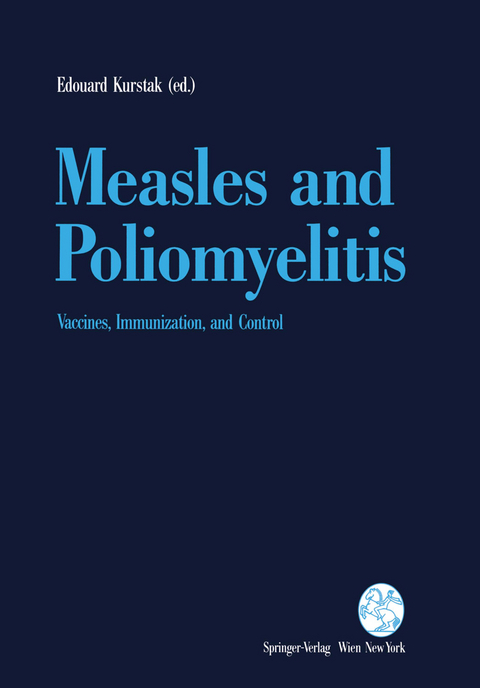
Measles and Poliomyelitis
Springer Wien (Verlag)
978-3-211-82436-8 (ISBN)
Das Buch enthält 31 Beiträge international anerkannter Experten auf dem Gebiet der Infektionskrankheiten Masern und Kinderlähmung. Neben einem Überblick über den gegenwärtigen Stand der Forschung sowie Informationen über Impfungen, ihre Wirkungen und ihren Schutz werden auch umfangreiche Programme zur Kontrolle/Bekämpfung dieser Krankheiten vorgestellt.
Elimination of measles and poliomyelitis diseases from the globe is a priority goal of the World Health Organization. For the first time, in a single volume comprising thirty-one well-documented chapters, internationally recognized experts provide a state-of-the-art treatment of these two important viral diseases. The book offers a wide range of new findings and references on the latest advances regarding the measles and poliomyelitis:- global and molecular genetic epidemiology, characteristics and diseases surveillance- all available vaccines and research to produce more safe and more potent-biotechnologyvaccines- immunization programmes, considering the available vaccines and possibility of vaccinal associations in strategy to eliminate/eradicate these diseases- immunity to infections and immunogenicity of vaccines- virus genomes organization and antigenic structures related to vaccine characteristics, stressing their role in immunization strategies- needs of global cooperation, using all available resources, vaccines and strategies to achieve the global control of the diseases.It is addressed to all public health professionals concerned with measles and poliomyelitis control, especially in hospitals, clinics, governmental health services, international health services, centers of infectious diseases, research institutes, medical schools, vaccine producers and experts in immunization strategies and programmes.
Editor's introduction Measles and poliomyelitis: vaccines, immunization, and control.- I. Measles Global Control.- 1. Challenges for the global control of measles in the 1990's.- 2. The experience with measles in the United States.- 3. Mass vaccination programme aimed at eradication of measles in Sweden.- 4. Identification of high risk groups for measles immunization.- 5. Is measles eradicable?.- 6. Safety of measles vaccines.- 7. Measles vaccines-one versus two doses: why and when.- 8. Cost-benefit analysis of a second dose measles inoculation of children.- 9. High-titer measles virus vaccines: protection evaluation.- 10. Recent approaches in the development of measles vaccines.- 11. Molecular biological basis of measles virus strain differences.- 12. Measles virus antigenic variations and the role of individual antigens in immunization.- 13. Cell-mediated immune response to measles virus.- II. Towards Poliomyelitis Eradication.- 14. Lessons from poliovirus control: strategies for eradication.- 15. Eradication of poliomyelitis: countdown or slowdown.- 16. The potential for poliovirus eradication.- 17. Poliovirus immunization situation in China.- 18. Epidemiologic and laboratory classification systems for paralytic poliomyelitis cases.- 19. Monitoring of the environment as a means of poliovirus surveillance.- 20. Criteria for the certification of poliomyelitis eradication.- 21. Poliovirus vaccine formulations.- 22. Inactivated and live attenuated poliovirus vaccines: mucosal immunity.- 23. Immunogenicity of poliovirus vaccines with special reference to the choice between oral and inactivated vaccines in developing countries.- 24. Optimal schedule for the administration of oral poliovirus vaccine.- 25. Poliovirus combined immunization with inactivated and liveattenuated vaccines.- 26. Antigenicity and immunogenicity of inactivated poliovirus vaccine in combined vaccine trials.- 27. Studies aiming at improvement of inactivated poliovirus vaccine preparations.- 28. Development of candidates for new types 2 and 3 oral poliovirus recombinant vaccines.- 29. Intratypic differentiation of polioviruses.- 30. Natural evolution of oral vaccine poliovirus strains.- 31. Stability of attenuated poliovirus strain genotypes in the human intestinal tract.
| Erscheint lt. Verlag | 5.8.1993 |
|---|---|
| Zusatzinfo | XI, 411 p. |
| Verlagsort | Vienna |
| Sprache | englisch |
| Maße | 170 x 244 mm |
| Gewicht | 796 g |
| Themenwelt | Medizin / Pharmazie ► Medizinische Fachgebiete ► Mikrobiologie / Infektologie / Reisemedizin |
| Medizin / Pharmazie ► Medizinische Fachgebiete ► Pharmakologie / Pharmakotherapie | |
| Medizin / Pharmazie ► Pharmazie | |
| Studium ► Querschnittsbereiche ► Infektiologie / Immunologie | |
| Naturwissenschaften ► Biologie ► Mikrobiologie / Immunologie | |
| Schlagworte | Antigen • Biotechnology • Diseases • Infection • Infections • infectious disease • Infectious Diseases • Kinderlähmung • Masern-Virus • Research • Vaccination • Vaccine • vaccines • Virus |
| ISBN-10 | 3-211-82436-7 / 3211824367 |
| ISBN-13 | 978-3-211-82436-8 / 9783211824368 |
| Zustand | Neuware |
| Haben Sie eine Frage zum Produkt? |
aus dem Bereich


